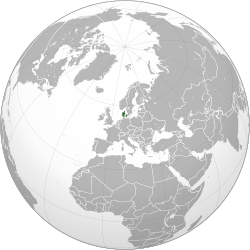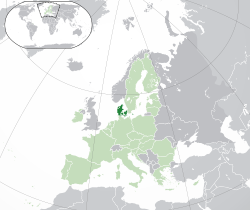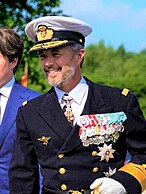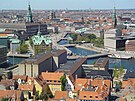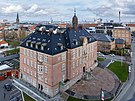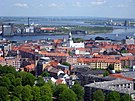Denmark
Denmark Danmark (Danish) | |
|---|---|
| Anthem: Der er et yndigt land (Danish) (English: "There is a lovely country") | |
| National and royal anthem: Kong Christian stod ved højen mast (Danish)[N 1] (English: "King Christian stood by the lofty mast") | |
Location of metropolitan Denmark (dark green)
Location of the European Union (light green) | |
Ethnic groups (2020) | |
| Religion (2020) |
|
| Demonym(s) | |
| Government | Unitary parliamentary constitutional monarchy |
• Monarch | Frederik X |
| Mette Frederiksen | |
| Legislature | Folketing |
| Area | |
• Total | 43,094[8] km2 (16,639 sq mi) (130th) |
• Water (%) | 1.74[9] |
| Highest elevation (Møllehøj) | 170.86 m (560.56 ft) |
| Population | |
• February 2023 estimate | |
• Density | 138.22/km2 (358.0/sq mi) |
| GDP (PPP) | 2024 estimate |
• Total | |
• Per capita | |
| GDP (nominal) | 2024 estimate |
• Total | |
• Per capita | |
| Gini (2022) | low |
| HDI (2022) | very high · 5th |
| Currency | Danish krone[N 6] |
| Time zone | UTC+01:00 (CET) |
• Summer (DST) | UTC+02:00 (CEST) |
| Calling code | +45 |
| Internet TLD | .dk[N 7] |
| Website | denmark |
Denmark (Danish: Danmark, pronounced [ˈtænmɑk] ⓘ) is a Nordic country in the south-central portion of Northern Europe. It is the metropolitan part of and the most populous constituent of the Kingdom of Denmark,[N 8] a constitutionally unitary state that includes the autonomous territories of the Faroe Islands and Greenland in the North Atlantic Ocean.[14] Metropolitan Denmark[N 9] is the southernmost of the Scandinavian countries, lying south-west and south of Sweden, south of Norway,[N 10] and north of Germany, with which it shares a short border, Denmark's only land border.
As of 2013, the Kingdom of Denmark, including the Faroe Islands and Greenland, had a total of 1,419 islands greater than 100 square metres (1,100 sq ft) in area; 443 of these have been named and 78 are inhabited.[15] Spanning a total area of 42,943 km2 (16,580 sq mi),[16] metropolitan Denmark consists of the northern part of the Jutland peninsula and an archipelago of 406 islands.[17] Of these, the most populated island is Zealand, on which the capital and largest city, Copenhagen, is situated, followed by Funen, the North Jutlandic Island, and Amager.[18] Denmark has flat, arable land, sandy coasts, low elevations, and a temperate climate. It had a population of 5,964,059 (1 December 2023), of whom 800,000 live in Copenhagen (2 million in the wider area).[19] Denmark exercises hegemonic influence in the Danish Realm, devolving powers to handle internal affairs. Home rule was established in the Faroe Islands in 1948 and in Greenland in 1979; the latter obtained further autonomy in 2009.[20]
The unified Kingdom of Denmark emerged in the 8th century AD as a proficient maritime power amid the struggle for control of the Baltic Sea.[2] In 1397, it joined Norway and Sweden to form the Kalmar Union, which persisted until the latter's secession in 1523. The remaining Kingdom of Denmark–Norway endured a series of wars in the 17th century that resulted in further territorial cessions. A surge of nationalist movements in the 19th century were defeated in the First Schleswig War of 1848. The adoption of the Constitution of Denmark on 5 June 1849 ended the absolute monarchy and introduced the current parliamentary system. An industrialised exporter of agricultural produce in the second half of the 19th century, Denmark introduced social and labour-market reforms in the early 20th century, which formed the basis for the present welfare state model and advanced mixed economy. Denmark remained neutral during World War I; Danish neutrality was violated in World War II by a rapid German invasion in April 1940. During occupation, a resistance movement emerged in 1943, while Iceland declared independence in 1944; Denmark was liberated after the end of the war in May 1945. In 1973, Denmark, together with Greenland but not the Faroe Islands, became a member of what is now the European Union, but negotiated certain opt-outs, such as retaining its own currency, the krone.
Denmark is a developed country with a high standard of living. It is a founding member of NATO, the Nordic Council, the OECD, the OSCE, and the United Nations, and is part of the Schengen Area. Denmark maintains close political, cultural, and linguistic ties with its Scandinavian neighbours, with the Danish language being partially mutually intelligible with both Norwegian and Swedish.
Etymology
The etymology of the name "Denmark", the relationship between "Danes" and "Denmark", and the emergence of Denmark as a unified kingdom are topics of continuous scholarly debate.[21][22] This is centred primarily on the morpheme "Dan" and whether it refers to the Dani or a historical person Dan and the exact meaning of the -"mark" ending.
Most etymological dictionaries and handbooks derive "Dan" from a word meaning "flat land",[23] related to German Tenne "threshing floor", English den "cave".[23] The element mark is believed to mean woodland or borderland (see marches), with probable references to the border forests in south Schleswig.[24]
The first recorded use of the word Danmark within Denmark itself is found on the two Jelling stones, which are runestones believed to have been erected by Gorm the Old (c. 955) and Harald Bluetooth (c. 965). The larger of the two stones is popularly cited as the "baptismal certificate" (dåbsattest) of Denmark,[25] though both use the word "Denmark", in the accusative ᛏᛅᚾᛘᛅᚢᚱᚴ tanmaurk ([danmɒrk]) on the large stone, and the genitive ᛏᛅᚾᛘᛅᚱᚴᛅᚱ "tanmarkar" (pronounced [danmarkaɽ]) on the small stone, while the dative form tąnmarku (pronounced [danmarkʊ]) is found on the contemporaneous Skivum stone. The inhabitants of Denmark are there called tani ([danɪ]), or "Danes", in the accusative.
History
Prehistory
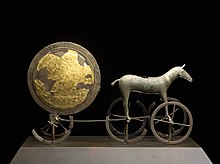
The earliest
During the
The tribal Danes came from the east
A short note about the Dani in
Viking and Middle Ages
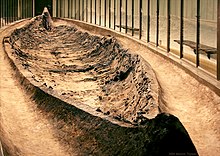
From the 8th to the 10th century the wider
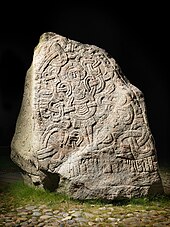
Denmark was largely consolidated by the late 8th century and its rulers are consistently referred to in Frankish sources as kings (reges). Under the reign of Gudfred in 804 the Danish kingdom may have included all the lands of Jutland, Scania and the Danish islands, excluding Bornholm.[33]
The extant Danish monarchy traces its roots back to
Throughout the
In 1397, Denmark entered into a
Early modern history (1536–1849)
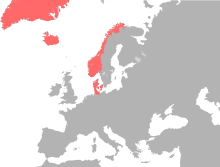
After Sweden permanently
In the
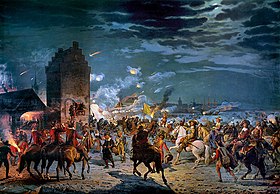
Seeing an opportunity to tear up the Treaty of Brømsebro, King Frederick III of Denmark, in 1657, declared war on Sweden, the latter being deeply involved in the Second Northern War (1655–1660), and marched on Bremen-Verden. This led to a massive Danish defeat as the armies of King Charles X Gustav of Sweden conquered Jutland and, following the Swedish March across the frozen Danish straits, occupied Funen and much of Zealand before signing the Peace of Roskilde in February 1658, which gave Sweden control of Scania, Blekinge, Bohuslän, Trøndelag, and the island of Bornholm. Charles X Gustav quickly regretted not having ruined Denmark and in August 1658, he launched a second attack on Denmark, conquered most of the Danish islands, and began a two-year-long siege of Copenhagen. King Frederick III actively led the defence of the city, rallying its citizens to take up arms, and repelled the Swedish attacks.[41][42] The siege ended following the death of Charles X Gustav in 1660.[43] In the ensuing peace settlement, Denmark managed to maintain its independence and regain control of Trøndelag and Bornholm.[44] Attaining great popularity following the war, Frederick III used this to disband the elective monarchy in favour of absolute monarchy, which lasted until 1848 in Denmark.[45]
Denmark tried but failed to regain control of Scania in the
The union was dissolved by the Treaty of Kiel in 1814; the Danish monarchy "irrevocably and forever" renounced claims to the Kingdom of Norway in favour of the Swedish king.[47] Denmark kept the possessions of Iceland (which retained the Danish monarchy until 1944), the Faroe Islands and Greenland, all of which had been governed by Norway for centuries.[48] Apart from the Nordic colonies, Denmark continued to rule over Danish India from 1620 to 1869, the Danish Gold Coast (Ghana) from 1658 to 1850, and the Danish West Indies from 1671 to 1917.
Constitutional monarchy (1849–present)

A nascent Danish liberal and national movement gained momentum in the 1830s; after the European Revolutions of 1848, Denmark peacefully became a constitutional monarchy on 5 June 1849. A new constitution established a two-chamber parliament. Denmark faced war against both Prussia and Austrian Empire in what became known as the Second Schleswig War, lasting from February to October 1864. Denmark was defeated and obliged to cede Schleswig and Holstein to Prussia. This loss came as the latest in the long series of defeats and territorial losses that had begun in the 17th century. After these events, Denmark pursued a policy of neutrality in Europe.
Denmark
In 1939 Denmark signed a 10-year non-aggression pact with
Denmark was a founding member of
Constitutional change in 1953 led to a
Geography
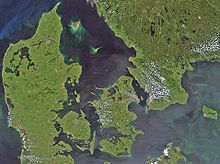
Located in
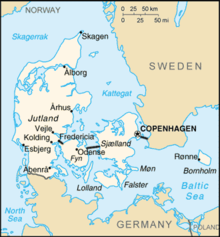
The country occupies a total area of 42,943.9
Denmark's northernmost point is
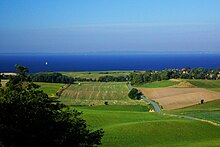
The country is flat with little elevation, having an average height
The Kingdom of Denmark includes two overseas territories, both well to the west of Denmark: Greenland, the world's largest island, and the Faroe Islands in the North Atlantic Ocean. These territories are self-governing under their own parliaments (the Løgting and Inatsisartut) and form, together with continental Denmark, part of the Danish Realm.
Climate
Denmark has a
Because of Denmark's northern location, there are large seasonal variations in daylight: short days during the winter with sunrise coming around 8:45 am and sunset 3:45 pm (standard time), as well as long summer days with sunrise at 4:30 am and sunset at 10 pm (daylight saving time).[61]
Ecology
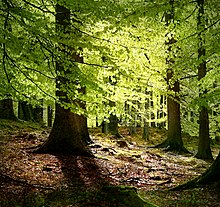
Denmark belongs to the
Roe deer occupy the countryside in growing numbers, and large-antlered red deer can be found in the sparse woodlands of Jutland. Denmark is also home to smaller mammals, such as polecats, hares and hedgehogs.[67] Approximately 400 bird species inhabit Denmark and about 160 of those breed in the country.[68] Large marine mammals include healthy populations of Harbour porpoise, growing numbers of pinnipeds and occasional visits of large whales, including blue whales and orcas. Cod, herring and plaice are abundant culinary fish in Danish waters and form the basis for a large fishing industry.[69]
Environment

Denmark stopped issuing new licences for oil and gas extraction in December 2020.[70]
Land and
Denmark's territories, Greenland and the Faroe Islands, catch approximately 650 whales per year.[79][80] Greenland's quotas for the catch of whales are determined according to the advice of the International Whaling Commission (IWC), having quota decision-making powers.[81]
Government and politics
Politics in Denmark operate under a framework laid out in the
Government

The Danish parliament is
Denmark is a representative democracy with universal suffrage.[N 13] Membership of the Folketing is based on proportional representation of political parties,[90] with a 2% electoral threshold. Denmark elects 175 members to the Folketing, with Greenland and the Faroe Islands electing an additional two members each—179 members in total.[91] Parliamentary elections are held at least every four years, but it is within the powers of the prime minister to ask the monarch to call for an election before the term has elapsed. On a vote of no confidence, the Folketing may force a single minister or an entire government to resign.[92]
The Government of Denmark operates as a
Following the 2022 Danish general election in November 2022, resident prime minister and Social Democratic leader Mette Frederiksen in December 2022 formed the current Frederiksen II Cabinet, a coalition government with the until then leading opposition party Venstre and the recently founded Moderate party.[94]
Law and judicial system

Denmark has a
The judicial system of Denmark is divided between courts with regular civil and
Danish Realm
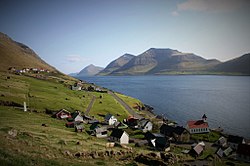
The Kingdom of Denmark is a unitary state that comprises, in addition to metropolitan Denmark, two autonomous territories[14] in the North Atlantic Ocean: the Faroe Islands and Greenland. They have been integrated parts of the Danish Realm since the 18th century; however, due to their separate historical and cultural identities, these parts of the Realm have extensive political powers and have assumed legislative and administrative responsibility in a substantial number of fields.[98] Home rule was granted to the Faroe Islands in 1948 and to Greenland in 1979, each having previously had the status of counties.[99]
The Faroe Islands and Greenland have their own home governments and parliaments and are effectively
| Autonomous territory | Population (2020) | Total area | Capital | Local parliament | Premier |
|---|---|---|---|---|---|
| 52,110[102] | 1,399 km2 (540.16 sq mi) | Løgting | Bárður á Steig Nielsen | ||
| 56,081[103] | 2,166,086 km2 (836,330 sq mi) | Inatsisartut | Múte Bourup Egede |
Administrative divisions
Denmark, with a total area of 43,094 square kilometres (16,639 sq mi), is divided into five administrative regions (Danish: regioner). The regions are further subdivided into 98 municipalities (kommuner). The easternmost land in Denmark, the Ertholmene archipelago, with an area of 39 hectares (0.16 sq mi), is neither part of a municipality nor a region but belongs to the Ministry of Defence.[104] The provinces of Denmark are statistical divisions of Denmark, positioned between the administrative regions and municipalities. They are not administrative divisions, nor subject for any kind of political elections, but are mainly for statistical use.
The regions were created on
Regions
The governing bodies of the regions are the regional councils, each with forty-one councillors elected for four-year terms. The councils are headed by regional district chairmen (regionsrådsformand), who are elected by the council.[106] The areas of responsibility for the regional councils are the
The
| Danish name | English name | Admin. centre | Largest city (populous) |
Population (April 2021) |
Total area (km2) |
|---|---|---|---|---|---|
| Hovedstaden | Capital Region of Denmark | Hillerød | Copenhagen | 1,856,061 | 2,568.29 |
| Midtjylland | Central Denmark Region | Viborg | Aarhus | 1,333,245 | 13,095.80 |
| Nordjylland | North Denmark Region |
Aalborg | Aalborg | 590,322 | 7,907.09 |
| Sjælland | Region Zealand | Sorø | Roskilde | 839,619 | 7,268.75 |
| Syddanmark | Region of Southern Denmark | Vejle | Odense | 1,224,100 | 12,132.21 |
| Source: Regional and municipal key figures | |||||
Foreign relations

Denmark wields considerable influence in Northern Europe and is a
As a member of Development Assistance Committee (DAC), Denmark has for a long time been among the countries of the world contributing the largest percentage of gross national income to development aid. In 2015, Denmark contributed 0.85% of its gross national income (GNI) to foreign aid and was one of only six countries meeting the longstanding UN target of 0.7% of GNI.[N 15][112] The country participates in both bilateral and multilateral aid, with the aid usually administered by the Ministry of Foreign Affairs. The organisational name of Danish International Development Agency (DANIDA) is often used, in particular when operating bilateral aid.
Military

Denmark's
Denmark is a long-time supporter of international
Economy
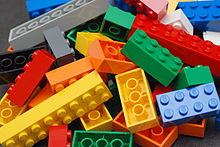
Denmark has a
Denmark has the fourth highest ratio of tertiary degree holders in the world.[126] The country ranks highest in the world for workers' rights.[127] GDP per hour worked was the 13th highest in 2009. The country has a market income inequality close to the OECD average,[128][129] but after taxes and public cash transfers the income inequality is considerably lower. According to Eurostat, Denmark's Gini coefficient for disposable income was the 7th-lowest among EU countries in 2017.[130] According to the
Once a predominantly
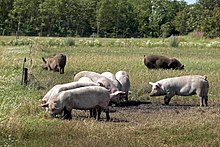
Denmark is part of the
Denmark's currency, the
Ranked by turnover in Denmark, the largest Danish companies are:
The Danish government focused into methods to increase
Public policy
Danes enjoy a high standard of living and the Danish economy is characterised by extensive government welfare provisions. Denmark has a corporate tax rate of 22% and a special time-limited tax regime for expatriates.[143] The Danish taxation system is broad based, with a 25% value-added tax, in addition to excise taxes, income taxes and other fees. The overall level of taxation (sum of all taxes, as a percentage of GDP) was 46% in 2017.[144] The tax structure of Denmark (the relative weight of different taxes) differs from the OECD average, as the Danish tax system in 2015 was characterised by substantially higher revenues from taxes on personal income and a lower proportion of revenues from taxes on corporate income and gains and property taxes than in OECD generally, whereas no revenues at all derive from social security contributions. The proportion deriving from payroll taxes, VAT, and other taxes on goods and services correspond to the OECD average[145]
As of 2014[update], 6% of the population was reported to live below the
Labour market
Like other Nordic countries, Denmark has adopted the
The level of unemployment benefits is dependent on former employment and normally on membership of an unemployment fund, which is usually closely connected to a trade union, and previous payment of contributions. Circa 65% of the financing comes from earmarked member contributions, whereas the remaining third originates from the central government and hence from general taxation.[154]
Science and technology
Denmark has a long tradition of scientific and technological invention and engagement, and has been involved internationally from the very start of the
In the 20th century, Danes have also been innovative in several fields of the technology sector. Danish companies have been influential in the shipping industry with the design of the largest and most energy efficient container ships in the world, the
Danish-born computer scientists and software engineers have taken leading roles in some of the world's programming languages:
Energy
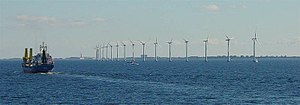
Denmark has considerably large deposits of oil and natural gas in the
Denmark's electricity sector has integrated energy sources such as wind power into the national grid. Denmark now aims to focus on intelligent battery systems (V2G) and plug-in vehicles in the transport sector.[165] The country is a member nation of the International Renewable Energy Agency (IRENA).[166]
Denmark exported roughly 460 million
Transport
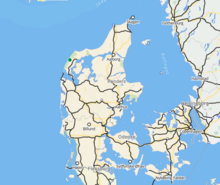

Significant investment has been made in building road and rail links between regions in Denmark, most notably the
Private vehicles are increasingly used as a means of transport. Because of the
With Norway and Sweden, Denmark is part of the Scandinavian Airlines flag carrier. Copenhagen Airport is Scandinavia's busiest passenger airport, handling over 25 million passengers in 2014.[168] Other notable airports are Billund Airport, Aalborg Airport, and Aarhus Airport.
Demographics
Population by ancestry (Q2 2020):[19]
Population
The population of Denmark, as registered by
Denmark is a historically
There are no official statistics on
The Inuit are Indigenous to Greenland in the Kingdom and have traditionally inhabited Greenland and the northern parts of Canada and Alaska in the Arctic. From the 18th century up to the 1970s, the Danish government (Dano-Norwegian until 1814) tried to assimilate the Greenlandic Inuit, encouraging them to adopt the majority language and culture. Because of this "Danization process", some persons of Inuit ancestry now identify their mother tongue as Danish.
Largest cities in Denmark (as of 1 January 2016[update])
| ||||||||||
|---|---|---|---|---|---|---|---|---|---|---|
| Rank | Core City
|
Region | Urban Population | Municipal Population | ||||||
| 1 | Copenhagen | Capital Region of Denmark | 1,280,371 | 591,481 | ||||||
| 2 | Aarhus | Central Denmark Region | 264,716 | 330,639 | ||||||
| 3 | Odense | Region of Southern Denmark | 175,245 | 198,972 | ||||||
| 4 | Aalborg | North Denmark Region |
112,194 | 210,316 | ||||||
| 5 | Esbjerg | Region of Southern Denmark | 72,151 | 115,748 | ||||||
| 6 | Randers | Central Denmark Region | 62,342 | 97,520 | ||||||
| 7 | Kolding | Region of Southern Denmark | 59,712 | 91,695 | ||||||
| 8 | Horsens | Central Denmark Region | 57,517 | 87,736 | ||||||
| 9 | Vejle | Region of Southern Denmark | 54,862 | 111,743 | ||||||
| 10 | Roskilde | Region Zealand | 50,046 | 86,207 | ||||||
| Source: Statistics Denmark | ||||||||||
Languages
Danish is the de facto national language of Denmark.[187] Faroese and Greenlandic are the official languages of the Faroe Islands and Greenland respectively.[187] German is a recognised minority language in the area of the former South Jutland County (now part of the Region of Southern Denmark), which was part of the German Empire prior to the Treaty of Versailles.[187] Danish and Faroese belong to the North Germanic (Nordic) branch of the Indo-European languages, along with Icelandic, Norwegian, and Swedish.[188] There is some degree of mutual intelligibility between Danish, Norwegian, and Swedish. Danish is more distantly related to German, which is a West Germanic language. Greenlandic or "Kalaallisut" is an Inuit language, and is entirely unrelated to Danish,[188] although it has adopted many Danish loanwords including the words for numbers.
A large majority (86%) of Danes speak English as a second language,[189] generally with a high level of proficiency. German is the second-most spoken foreign language, with 47% reporting a conversational level of proficiency.[187] Denmark had 25,900 native speakers of German in 2007 (mostly in the South Jutland area).[187]
Religion
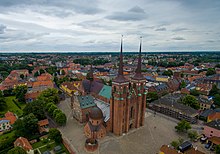
The
According to a 2010 Eurobarometer Poll,[201] 28% of Danish nationals polled responded that they "believe there is a God", 47% responded that they "believe there is some sort of spirit or life force" and 24% responded that they "do not believe there is any sort of spirit, God or life force". Another poll, carried out in 2009, found that 25% of Danes believe Jesus is the son of God, and 18% believe he is the saviour of the world.[202]
Education

All educational programmes in Denmark are regulated by the
Following graduation from compulsory education, there are several continuing educational opportunities; the
The government records upper secondary school completion rates of 95% and tertiary enrollment and completion rates of 60%.[204] All university and college (tertiary) education in Denmark is free of charges; there are no tuition fees to enrol in courses. Students aged 18 or above may apply for state educational support grants, known as Statens Uddannelsesstøtte (SU), which provides fixed financial support, disbursed monthly.[205] Danish universities offer international students a range of opportunities for obtaining an internationally recognised qualification in Denmark. Many programmes may be taught in the English language, the academic lingua franca, in bachelor's degrees, master's degrees, doctorates and student exchange programmes.[206]
Health

As of 2015[update], Denmark has a
Denmark has a
Vulnerable residential areas

Certain
During the years 2010–2021, the term "ghetto" was used officially to designate some or all of the vulnerable areas.[218] The term was considered controversial, however, and removed in 2021.[220][221][222] Denmark is the only country to have officially used the word 'ghetto' in the 21st century to denote certain residential areas.[223] From 2021, four different lists are published, depending on the residents' income levels, employment status, education levels, criminal convictions and origin (a statistical criterion based on parents' geographical birthplace and citizenship).[224][218][225] In 2023, there were 19 vulnerable residential areas in Denmark.[226]
Culture
Denmark shares strong cultural and

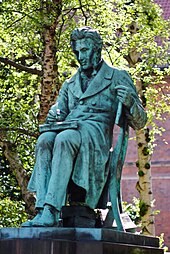
The astronomical discoveries of
A major feature of Danish culture is
There are seven heritage sites inscribed on the UNESCO
Human rights
Denmark has been considered a progressive country, which has adopted legislation and policies to support women's rights, minority rights, and
In 2009, a referendum on changing the Danish Act of Succession were held to grant
The Inuit have for decades been the subject of discrimination and abuse by the dominant colonisers from
Denmark was the first country in the world to grant legal recognition to same-sex unions in the form of registered partnerships in 1989. On 7 June 2012, the law was replaced by a new same-sex marriage law, which came into effect on 15 June 2012.[241] Greenland and the Faroe Islands legalised same-sex marriage in April 2016,[242] and in July 2017 respectively.[243] In January 2016, a resolution was implemented by the Danish parliament which prevented transgender identity being classified as a mental health condition.[244] In doing so, Denmark became the first country in Europe to go against the World Health Organisation (WHO) standards, which classified transgender identity as being a mental health issue until June 2018.[245][246]
Media
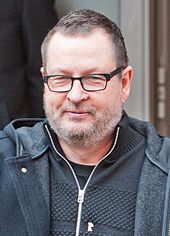
Danish cinema dates back to 1897 and since the 1980s has maintained a steady stream of productions due largely to funding by the state-supported
Other Danish filmmakers of note include
Danish
Modern Danish mass media and news programming are dominated by a few large corporations. In printed media
Music
Denmark and its multiple outlying islands have a wide range of folk traditions. The country's most famous classical composer is Carl Nielsen (1865–1931), especially remembered for his six symphonies and his Wind Quintet, while the Royal Danish Ballet specialises in the work of the Danish choreographer August Bournonville. The Royal Danish Orchestra is among the world's oldest orchestras.[251] Danes have distinguished themselves as jazz musicians, and the Copenhagen Jazz Festival has acquired international recognition.
The modern
Denmark has participated in the Eurovision Song Contest since 1957 and has won the contest three times, in 1963, 2000 and 2013.
Architecture and design

Denmark's architecture became firmly established in the
The 20th century brought along new architectural styles; including
Danish design is a term often used to describe a style of functionalistic design and architecture that was developed in the mid-20th century, originating in Denmark. Danish design is typically applied to industrial design, furniture and household objects, which have won many international awards. The Royal Porcelain Factory is famous for the quality of its ceramics. Danish design is also a well-known brand, often associated with world-famous, 20th-century designers and architects such as Børge Mogensen, Finn Juhl, Hans Wegner, Arne Jacobsen, Poul Henningsen and Verner Panton.[256] Other designers of note include Kristian Solmer Vedel in the area of industrial design, Jens Quistgaard for kitchen furniture and implements and Ole Wanscher who had a classical approach to furniture design.
Literature and philosophy

The first known Danish literature is myths and folklore from the 10th and 11th century. Saxo Grammaticus, normally considered the first Danish writer, worked on a chronicle of Danish history (Gesta Danorum). Very little is known of other Danish literature from the Middle Ages. With the Age of Enlightenment came Ludvig Holberg whose comedy plays are still being performed.
In the late 19th century, literature was seen as a way to influence society. Known as the
Danish philosophy has a long tradition as part of Western philosophy. Perhaps the most influential Danish philosopher was Søren Kierkegaard, the creator of Christian existentialism. Kierkegaard had a few Danish followers, including Harald Høffding, who later in his life moved on to join the movement of positivism. Another Danish philosopher of note is Grundtvig, whose philosophy gave rise to a new form of non-aggressive nationalism in Denmark, and who is also influential for his theological and historical works.
Painting and photography

While Danish art was influenced over the centuries by trends in Germany and the Netherlands, the 15th and 16th century church frescos, which can be seen in many of the country's older churches, are of particular interest as they were painted in a style typical of native Danish painters.[257]
The Danish Golden Age, which began in the first half of the 19th century, was inspired by a new feeling of nationalism and romanticism, typified in the later previous century by history painter Nicolai Abildgaard. Christoffer Wilhelm Eckersberg was not only a productive artist in his own right but taught at the Royal Danish Academy of Fine Arts where his students included Wilhelm Bendz, Christen Købke, Martinus Rørbye, Constantin Hansen, and Wilhelm Marstrand.
In 1871,
Painting has continued to be a prominent form of artistic expression in Danish culture, inspired by and also influencing major international trends in this area. These include
Danish photography has developed from strong participation and interest in the very beginnings of the art of photography in 1839. Pioneers such as Mads Alstrup and Georg Emil Hansen paved the way for a rapidly growing profession during the last half of the 19th century. Today Danish photographers such as Astrid Kruse Jensen and Jacob Aue Sobol are active in key exhibitions around the world.[261]
Cuisine
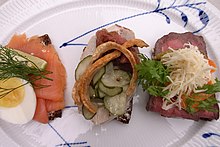
The traditional cuisine of Denmark, like that of the other Nordic countries and of Northern Germany, consists mainly of meat, fish and potatoes. Danish dishes are highly seasonal, stemming from the country's agricultural past, its geography, and its climate of long, cold winters.
The open sandwiches on rye bread, known as .
Since around 1970, chefs and restaurants across Denmark have introduced
Sports
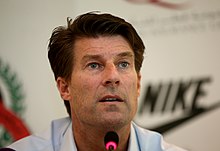
Sports are popular in Denmark, and its citizens participate in and watch a wide variety. The
In recent years, Denmark has made a mark as a strong cycling nation, with Michael Rasmussen reaching King of the Mountains status in the Tour de France in 2005 and 2006. Other popular sports include golf—which is mostly popular among those in the older demographic;[265] tennis—in which Denmark is successful on a professional level; basketball—Denmark joined the international governing body FIBA in 1951;[266] rugby—the Danish Rugby Union dates back to 1950;[267] ice hockey—often competing in the top division in the Men's World Championships; rowing—Denmark specialise in lightweight rowing and are particularly known for their lightweight coxless four, having won six gold and two silver World Championship medals and three gold and two bronze Olympic medals; and several indoor sports—especially badminton, table tennis and gymnastics, in each of which Denmark holds World Championships and Olympic medals.
See also
- Index of Denmark-related articles
- Outline of Denmark
- Religion in Denmark
Explanatory notes
- royal and military occasions.[1]
- ^ German is recognised as a protected minority language in the South Jutland area of Denmark.
- German
- ^ The Kingdom has a total population of 5,958,380.
- ^ a b c This data is for Denmark proper only. For data relevant to Greenland and the Faroe Islands see their respective articles.
- ^ In the Faroe Islands the currency has a separate design and is known as the króna, but is not a separate currency.[citation needed]
- top-level domain name .eu is shared with other European Unioncountries.
- ^ Danish: Kongeriget Danmark, pronounced [ˈkʰɔŋəʁiːð̩ ˈtænmɑk] ⓘ.
- ^ a b The Kingdom of Denmark's territory in continental Europe is referred to as "metropolitan Denmark",[53] "Denmark proper" (Danish: egentlig Danmark), or simply "Denmark". In this article, usage of "Denmark" excludes the Faroe Islands and Greenland.
- ^ The island of Bornholm is offset to the east of the rest of the country, in the Baltic Sea.
- codified constitution. Changes to it require an absolute majority in two consecutive parliamentary terms and the approval of at least 40% of the electorate through a referendum.[82]
- ^ The Constitution refers to "the King" (Danish: kongen), rather than the gender-neutral term "monarch". In light of the restriction of powers of the monarchy, this is best interpreted as referring to the government Cabinet.
- index of democracy.[89]
- a referendum.
- ^ As measured in official development assistance (ODA). Denmark, Luxembourg, the Netherlands, Norway, Sweden and the United Kingdom exceeded the United Nations' ODA target of 0.7% of GNI.
- ^ The Church of Denmark is the established church (or state religion) in Denmark and Greenland; the Church of the Faroe Islands became an independent body in 2007.
Citations
- ^ "Not one but two national anthems". Ministry of Foreign Affairs of Denmark. Archived from the original on 15 May 2014. Retrieved 18 May 2014.
- ^ a b c Stone et al. (2008), p. 31.
- ^ "Denmark". The World Factbook. CIA. 29 April 2010. Archived from the original on 5 July 2021. Retrieved 11 May 2010.
- ^ "Bekendtgørelse af ILO-konvention nr. 169 af 28. juni 1989 vedrørende oprindelige folk og stammefolk i selvstændige stater". Retsinformation.dk. 9 October 1997. Archived from the original on 8 October 2020. Retrieved 30 September 2020.
- ^ "Den dansk-tyske mindretalsordning". UM.dk. Archived from the original on 29 September 2020. Retrieved 30 September 2020.
- ^ a b "Folkekirkens medlemstal" (in Danish). Kirkeministeriet. Archived from the original on 10 April 2020. Retrieved 6 January 2021.
- ^ Arly Jacobsen, Brian (8 February 2018). "Hvor mange muslimer bor der i Danmark?" (in Danish). Religion.dk. Archived from the original on 9 December 2018. Retrieved 6 January 2021.
- ^ "Denmark". Central Intelligence Agency. 21 November 2023. Archived from the original on 5 July 2021. Retrieved 22 November 2023 – via CIA.gov.
- Organisation for Economic Co-operation and Development (OECD). Archivedfrom the original on 24 March 2021. Retrieved 11 October 2020.
- ^ "Population and population projections". Statistics Denmark. Archived from the original on 30 October 2018. Retrieved 11 August 2022.
- ^ a b c d "World Economic Outlook Database, April 2024 Edition. (Denmark)". www.imf.org. International Monetary Fund. 16 April 2024. Retrieved 17 April 2024.
- ^ "Gini coefficient of equivalised disposable income – EU-SILC survey". ec.europa.eu. Eurostat. Archived from the original on 9 October 2020. Retrieved 25 November 2023.
- ^ "Human Development Report 2023/24" (PDF). United Nations Development Programme. 13 March 2024. p. 288. Archived (PDF) from the original on 13 March 2024. Retrieved 13 March 2024.
- ^ a b *Benedikter, Thomas (19 June 2006). "The working autonomies in Europe". Society for Threatened Peoples. Archived from the original on 9 March 2008. Retrieved 8 June 2012.
Denmark has established very specific territorial autonomies with its two island territories
- Ackrén, Maria (November 2017). "Greenland". Autonomy Arrangements in the World. Archived from the original on 30 August 2019. Retrieved 30 August 2019.
Faroese and Greenlandic are seen as official regional languages in the self-governing territories belonging to Denmark.
- "Greenland". International Cooperation and Development. European Commission. 3 June 2013. Archived from the original on 16 September 2014. Retrieved 27 August 2019.
Greenland [...] is an autonomous territory within the Kingdom of Denmark
- Ackrén, Maria (November 2017). "Greenland". Autonomy Arrangements in the World. Archived from the original on 30 August 2019. Retrieved 30 August 2019.
- ^ "About Denmark". Archived from the original on 27 December 2022. Retrieved 27 December 2022.
- ^ a b "Area". Statistics Denmark. Archived from the original on 14 April 2019.
- ^ a b "Denmark in numbers 2010" (PDF). Statistics Denmark. Archived (PDF) from the original on 18 April 2013. Retrieved 2 May 2013.
- ^ "Statistikbanken". statistikbanken.dk. Archived from the original on 6 June 2023. Retrieved 27 December 2022.
- ^ a b c d e "Population at the first day of the quarter by municipality, sex, age, marital status, ancestry, country of origin and citizenship". Statistics Denmark. Archived from the original on 22 December 2022. Retrieved 2 October 2020.
January 2020
- ^ "Greenland and the Faroe Islands". Ministry of Foreign Affairs Denmark. Archived from the original on 18 December 2023. Retrieved 18 December 2023.
- ^ Kristian Andersen Nyrup, Middelalderstudier Bog IX. Kong Gorms Saga Archived 9 January 2010 at the Wayback Machine
- ISBN 978-87-7674-204-1, pp. 19–24
- ^ a b J. de Vries, Altnordisches etymologisches Wörterbuch, 1962, 73; N. Å. Nielsen, Dansk etymologisk ordbog, 1989, 85–96.
- ^ Navneforskning, Københavns Universitet"Udvalgte stednavnes betydning". Archived from the original on 16 July 2006. Retrieved 27 January 2008.
- ISBN 978-0-470-77683-4. Archivedfrom the original on 12 April 2016. Retrieved 21 October 2015.
- ^ Michaelsen (2002), p. 19.
- ^ a b Nielsen, Poul Otto (May 2003). "Denmark: History, Prehistory". Ministry of Foreign Affairs of Denmark. Archived from the original on 22 November 2005. Retrieved 1 May 2006.
- ^ Busck (2002), p. 20.
- ^ Busck (2002), p. 19.
- Charles C. Mierow. Archivedfrom the original on 24 April 2006. Retrieved 1 May 2006.
- ^ Michaelsen (2002), pp. 122–123.
- ^ a b *Lund, Niels (May 2003). "Denmark – History – The Viking Age". Ministry of Foreign Affairs of Denmark. Archived from the original on 10 May 2006. Retrieved 24 June 2012.
- ISBN 978-1-139-46836-7– via Google Books.
- ^ Stone et al. (2008), p. 33.
- ^ Lauring, Palle (1960) A History of the Kingdom of Denmark, Host & Son Co.: Copenhagen, p. 108.
- ^ "Kalmarkriget 1611–1613". Svenskt Militärhistoriskt Bibliotek. Archived from the original on 11 October 2007. Retrieved 4 May 2007.
- ^ Rawlinson, Kevin (5 November 2018). "Prince Charles says Britain's role in slave trade was an atrocity". The Guardian. Archived from the original on 5 November 2018. Retrieved 6 November 2018.
- ISBN 978-0-313-26257-9. Retrieved 15 May 2014.
- ^ Parker (1984), p. 78.
- ^ Parker (1984), p. 79.
- ^ Isacson (2002), p. 229.
- ^ Englund (2000), p. 610.
- ^ Stone et al. (2008), p. 35.
- ^ Frost (2000), pp. 180–183.
- from the original on 23 January 2022. Retrieved 27 March 2021.
- ^ "League of Armed Neutrality". Oxford Reference. Archived from the original on 24 September 2015. Retrieved 28 August 2015.
- ^ Jenssen-Tusch, Georg Friedrich (1852). Zur Regierungsgeschichte Friedrich VI. Königs von Dänemark, Herzogs von Schleswig, Holstein und Lauenburg (in German). Verlag Schröder. p. 166.
- ISBN 978-3-16-148311-0.
- ISBN 978-2-7605-2209-1. Archivedfrom the original on 12 April 2016. Retrieved 21 October 2015.
- ^ "Lost in translation: Epic goes to Denmark". Politico. 6 June 2019. Archived from the original on 12 April 2020. Retrieved 10 June 2019.
- ^ Rugg, Andy. "Traitor Danes: most soldiers return heroes, but this lot came home total zeroes". Copenhagen Post. Archived from the original on 29 January 2013. Retrieved 30 January 2013.
- ^ "Finland: Now, the Seven and a Half". Time. 7 April 1961. Archived from the original on 4 November 2011. Retrieved 18 July 2009.
- ^ Administrative divisions – Denmark Archived 25 March 2021 at the Wayback Machine The World Factbook. Access date: 16 September 2021
- ^ "Facts and Figures Archived 30 June 2010 at the Wayback Machine", Danish Defence, Defence Command Denmark. Retrieved 11 June 2010.
- ^ "Nature & Environment". Ministry of Foreign Affairs of Denmark. Archived from the original on 3 April 2007. Retrieved 3 February 2007.
- ^ Nationalencyklopedin, (1990)
- ^ "Nyt højeste punkt i Danmark" (in Danish). Danish Geodata Agency. Archived from the original on 28 May 2014. Retrieved 26 May 2014.
- ^ a b "Climate Normals for Denmark". Danish Meteorological Institute. Archived from the original on 3 January 2015. Retrieved 2 January 2015. Figures, labelled in Danish: First plot is the whole country; Nedbør=Precipitation, Nedbørdage=Precipitation days (>1 mm), (Dag/Middel/Nat)temp.=(Daytime/Average/Nighttime) temperature, Solskinstimer=Hours of sunshine.
- ^ "Vejrekstremer i Danmark [Weather extremes in Denmark]" (in Danish). Danish Meteorological Institute (DMI). 6 October 2016. Archived from the original on 19 October 2016. Retrieved 19 October 2016.
- ^ "The weather cross – the four corners of autumn weather". Danish Meteorological Institute. Archived from the original on 21 September 2015. Retrieved 17 September 2015.
- ^ "Copenhagen, Denmark – Sunrise, sunset, dawn and dusk times for the whole year". Gaisma. Archived from the original on 2 July 2012. Retrieved 24 June 2012.
- PMID 28608869.
- ^ Hogan, C. Michael. "Ecoregions of Denmark". Encyclopedia of Earth. Archived from the original on 24 September 2015. Retrieved 26 August 2015.
- ^ a b Jensen, Christian Lundmark. "Forests and forestry in Denmark – Thousands of years of interaction between man and nature" (PDF). Danish Ministry of the Environment Nature Agency. Archived from the original (PDF) on 15 July 2016. Retrieved 31 May 2016.
- ^ "Forest area (% of land area)". worldbank.org. The World Bank. Archived from the original on 5 September 2015. Retrieved 26 August 2015.
- PMID 33293507.
- ^ "Animals in Denmark". listofcountriesoftheworld.com. 2012. Archived from the original on 1 June 2016. Retrieved 31 May 2016.
- ^ "Bird list of Denmark". Netfugl.dk. Archived from the original on 5 September 2015. Retrieved 26 August 2015.
It involves all category A, B and C birds recorded in Denmark (according to SU/BOURC/AERC standard).
- ^ Byskov, Søren. "Theme: Herring, cod and other fish – 1001 Stories of Denmark". The Heritage Agency of Denmark. Archived from the original on 3 March 2016. Retrieved 31 May 2016.
- ^ Farand, Chloé (4 December 2020). "Denmark to phase out oil and gas production by 2050 in "watershed" decision". Climate Home News. Archived from the original on 4 December 2020. Retrieved 29 December 2020.
- ^ The law of environmental damage: liability and reparation. Marie-Louise Larsson.
- ^ a b "Denmark". The World Factbook. CIA. 19 January 2012. Archived from the original on 5 July 2021. Retrieved 4 February 2012.
- ^ "Ecological Footprint Atlas 2010". Global Footprint Network. 2010. Archived from the original on 9 July 2011. Retrieved 26 August 2015.
- ^ WWF (2014): Living Planet Report.
- ^ AMI (2012); preliminary data for 2011
- ^ Burck, Jan; Marten, Franziska; Bals, Christoph. "The Climate Change Performance Index: Results 2015" (PDF). Germanwatch. Archived from the original (PDF) on 9 December 2014. Retrieved 9 December 2014.
- ^ "2020 EPI Results". Environmental Performance Index. Archived from the original on 21 June 2023. Retrieved 20 November 2020.
- ^ "Climate change: Whisper it cautiously... there's been progress in run up to COP26". BBC. 25 September 2021. Archived from the original on 21 September 2022. Retrieved 10 October 2021.
- ^ "Almost Saving Whales: The Ambiguity of Success at the International Whaling Commission [Full Text] – Ethics & International Affairs". Ethics & International Affairs. 29 March 2012. Archived from the original on 27 December 2017. Retrieved 27 December 2017.
- ^ "Hundreds of whales slaughtered in Faroe Island's annual killing". The Independent. 20 June 2017. Archived from the original on 28 December 2017. Retrieved 27 December 2017.
- ^ "Greenland quotas for big whales". Government of Greenland. 5 January 2013. Archived from the original on 5 November 2018. Retrieved 4 November 2018.
- ^ Tschentscher, Axel. "The Constitution of Denmark – Section 88". Servat.unibe.ch. Archived from the original on 10 July 2011. Retrieved 12 February 2016.
- ^ "The executive power is vested in the King." The Constitution of Denmark – Section 3. Archived 10 July 2011 at the Wayback Machine
- ^ "The body of Ministers shall form the Council of State, in which the Successor to the Throne shall have a seat when he is of age. The Council of State shall be presided over by the King ..." The Constitution of Denmark – Section 17. Archived 10 July 2011 at the Wayback Machine
- ^ The Monarchy today Archived 15 February 2015 at the Wayback Machine – The Danish Monarchy (kongehuset.dk). Access date: 16 June 2012
- ^ "The King shall not be answerable for his actions; his person shall be sacrosanct." The Constitution of Denmark – Section 13. Archived 10 July 2011 at the Wayback Machine
- ^ Bryant, Miranda (14 January 2024). "Denmark's King Frederik X takes throne after Margrethe abdicates". The Guardian. Archived from the original on 21 February 2024. Retrieved 19 February 2024.
- ^ "A Bill passed by the Parliament shall become law if it receives the Royal Assent not later than thirty days after it was finally passed." The Constitution of Denmark – Section 22. Archived 10 July 2011 at the Wayback Machine
- ^ "Democracy Index 2014" (PDF). The Economist/Economist Intelligence Unit. 2015. Archived from the original (PDF) on 1 February 2016. Retrieved 23 August 2015.
- ^ "ICL – Denmark – Constitution – Section 31. Elections". unibe.ch. Archived from the original on 10 July 2011. Retrieved 12 February 2016.
- ^ Jørgensen 1995, p. 16.
- ^ "A Minister shall not remain in office after the Parliament has passed a vote of no confidence in him." The Constitution of Denmark – Section 15. Archived 10 July 2011 at the Wayback Machine
- Berlingske Tidende. 17 June 2007. Archived from the originalon 11 August 2011. Retrieved 17 August 2007.
- ^ "Danish PM picks right-leaning rivals as key ministers in new government". Reuters. 15 December 2022. Archived from the original on 31 May 2023. Retrieved 4 January 2023.
- ISBN 978-1-58477-180-7.
- ^ "The administration of justice shall always remain independent of the executive power. Rules to this effect shall be laid down by Statute ..." The Constitution of Denmark – Sections/Articles 62 and 64. Archived 10 July 2011 at the Wayback Machine
- ^ Gammelgaard & Sørensen 1998, p. 18.
- ^ The working autonomies in Europe Archived 9 March 2008 at the Wayback Machine – Gesellschaft für bedrohte Völker (GFBV). Retrieved 13 March 2012.
- ^ a b c The unity of the Realm Archived 20 January 2013 at the Wayback Machine – Statsministeriet – stm.dk. Retrieved 13 March 2012.
- ^ "Act on the Faroese authorities acquisition of affairs and fields" [Lov om de færøske myndigheders overtagelse af sager og sagsområder]. retsinformation.dk (in Danish). 24 June 2005. Archived from the original on 20 January 2016. Retrieved 11 June 2014.
- ^ Lov om Grønlands Selvstyre Archived 6 November 2018 at the Wayback Machine (in Danish). Retsinformation.dk. "I erkendelse af, at det grønlandske folk er et folk i henhold til folkeretten med ret til selvbestemmelse, bygger loven på et ønske om at fremme ligeværdighed og gensidig respekt i partnerskabet mellem Danmark og Grønland."
- ^ "Faroe Islands Population". Hagstova Føroya. Archived from the original on 15 May 2020. Retrieved 1 April 2020.
- ^ "2020 Population". Archived from the original on 5 May 2020. Retrieved 1 April 2020.
- ^ Michael Kjær, Jonas (15 November 2006). "Christiansø betaler ikke sundhedsbidrag". dr.dk (in Danish). Archived from the original on 11 October 2007. Retrieved 12 August 2007.
- ^ Denmark: Regions, Municipalities, Cities & Major Urban Areas Archived 8 April 2012 at the Wayback Machine – Statistics and Maps on City Population.
- ^ ISBN 978-87-7723-471-2.
- ^ "Regional Tasks in Denmark". Danske Regioner. Archived from the original on 10 May 2014. Retrieved 23 August 2015.
- ^ a b "The Danish Tax System". Aarhus University. Archived from the original on 21 August 2015. Retrieved 23 August 2015.
- from the original on 6 January 2016. Retrieved 1 May 2016.
- ^ "Danish Presidency of the European Union 2012". European Union. Archived from the original on 3 January 2012. Retrieved 25 May 2014.
- ^ Government of the United States. "US Department of State: Denmark". Archived from the original on 20 March 2021. Retrieved 25 May 2014.
- ^ "2015 Preliminary ODA Figures" (PDF). Paris: OECD. 13 April 2016. Archived (PDF) from the original on 8 May 2016. Retrieved 1 May 2016.
- ^ "Hjemmeværnet » Se Karrieremuligheder, Job & Løn". Forsvaret (in Danish). Archived from the original on 18 October 2022. Retrieved 18 October 2022.
- ^ Olesen, Gunnar (7 September 2011). "Denmark as a warring nation: A bracket that should be closed" (in Danish). The council for international conflict resolution (RIKO). Archived from the original on 15 February 2016. Retrieved 1 January 2016.
- ^ Lavrsen, Lasse (19 June 2010). "Danmark er en krisnation" (in Danish). Information. Archived from the original on 25 February 2016. Retrieved 1 January 2016.
- ^ "Forsvarsministerens Verdenskort". Ministry of Defense of Denmark. 27 December 2007. Archived from the original on 27 December 2007. Retrieved 20 August 2009.
- ^ Clark, A.L. (1996). Bosnia: What Every American Should Know. New York: Berkley Books.
- ^ Phillips, R. Cody. Bosnia-Hertsegovinia: The U.S. Army's Role in Peace Enforcement Operations 1995–2004. Washington, D.C.: United States Army Center of Military History. CMH Pub 70-97-1. Archived from the original on 9 December 2013.
- ^ "Denmark follows UK Iraq pullout". Al Jazeera English. 21 February 2007. Archived from the original on 11 December 2012. Retrieved 20 August 2009.
- ^ "Danmarks Radio – Danmark mister flest soldater i Afghanistan". Dr.dk. 15 February 2009. Archived from the original on 19 February 2009. Retrieved 5 July 2010.
- ^ Country and Lending Groups. Archived 2 July 2014 at the Wayback Machine World Bank. Accessed on 14 March 2016.
- ^ "Gross national income per capita 2017, Atlas method and PPP. World Development Indicators database, World Bank, 21 September 2018. Retrieved 6 December 2018" (PDF). Archived (PDF) from the original on 12 September 2014. Retrieved 6 December 2018.
- ^ "Country Ratings" Archived 16 September 2017 at the Wayback Machine, 2012 Index of Economic Freedom. Retrieved 12 January 2012.
- freetheworld.com. Fraser Institute. 2011. Archived from the original(PDF) on 26 September 2011. Retrieved 20 September 2011.
- ^ "Global Competitiveness Report 2018". World Economic Forum. Archived from the original on 8 December 2018. Retrieved 6 December 2018.
- ^ UNESCO 2009 Global Education Digest Archived 28 November 2011 at the Wayback Machine, Shared fourth with Finland at a 30.3% ratio. Graph on p28, table on p194.
- The Huffington Post. Retrieved 28 May 2014.
- ^ Joumard, Isabelle; Pisu, Mauro; Bloch, Debbie (2012). "Tackling income inequality. The role of taxes and transfers" (PDF). OECD. Archived (PDF) from the original on 28 December 2014. Retrieved 10 February 2015.
- ^ Neamtu, Ioana; Westergaard-Nielsen, Niels (March 2013). "Sources and impact of rising inequality in Denmark" (PDF). Archived (PDF) from the original on 11 February 2015. Retrieved 10 February 2015.
- ^ "Gini coefficient of equivalised disposable income – EU-SILC survey. Eurostat, last data update 20 November 2018, retrieved 6 December 2018". Archived from the original on 6 October 2014. Retrieved 6 December 2018.
- ^ "World Economic Outlook Database, October 2010 Edition". IMF. 6 October 2010. Archived from the original on 22 February 2011. Retrieved 5 July 2012.
- ^ Liz Alderman and Steven Greenhouse (27 October 2014). Living Wages, Rarity for U.S. Fast-Food Workers, Served Up in Denmark Archived 28 October 2014 at the Wayback Machine. The New York Times. Retrieved 28 October 2014.
- ^ On Sweden and Denmark, see Anders Kjellberg and Christian Lyhne Ibsen "Attacks on union organizing: Reversible and irreversible changes to the Ghent-systems in Sweden and Denmark" Archived 9 March 2017 at the Wayback Machine in Trine Pernille Larsen and Anna Ilsøe (eds.)(2016) Den Danske Model set udefra (The Danish Model Inside Out) – komparative perspektiver på dansk arbejdsmarkedsregulering, Copenhagen: Jurist- og Økonomforbundets Forlag (pp.292)
- ^ "StatBank Denmark, Table NABP10: 1-2.1.1 Production and generation of income (10a3-grouping) by transaction, industry and price unit. Retrieved on December 6, 2018". Archived from the original on 17 November 2018. Retrieved 6 December 2018.
- ^ a b c d "Denmark". The World Factbook. CIA. 3 December 2018. Archived from the original on 5 July 2021. Retrieved 18 December 2018.
- ^ "Eurostat: Net international investment position – quarterly data, % of GDP. Last update 24 October 2018, retrieved December 6 2018". Archived from the original on 26 November 2018. Retrieved 6 December 2018.
- ^ (in Danish) Danskerne og LO elsker globalisering. Newspaper article 17 November 2016 on finans.dk. Retrieved 6 December 2018. Archived 6 December 2018 at the Wayback Machine
- ^ "Denmark and the euro". Danmarks Nationalbank. 17 November 2006. Archived from the original on 16 November 2006. Retrieved 3 February 2007.
- ^ "Standard Eurobarometer 89 - Spring 2018 - Factsheets Denmark". Eurobarometer. June 2018. Archived from the original on 16 January 2022. Retrieved 18 December 2018.
- ^ "Standard Eurobarometer 100 - Autumn 2023 - Country Factsheets in English - Denmark". Eurobarometer. December 2023. Archived from the original on 5 March 2024. Retrieved 7 March 2024.
- ^ "The largest companies by turnover in Denmark". largestcompanies.com. Nordic Netproducts AB. Archived from the original on 6 November 2018. Retrieved 18 December 2018.
- ^ "Denmark mulls higher taxes for energy traders". 4 May 2023. Archived from the original on 20 November 2023. Retrieved 5 May 2023.
- ^ Business Environment Archived 21 February 2012 at the Wayback Machine, Invest in Denmark
- ^ "StatBank Denmark, SKTRYK: Tax level by national account groups. Retrieved December 6 2018". Archived from the original on 25 November 2018. Retrieved 6 December 2018.
- ^ "OECD Revenue Statistics 2018 – Denmark. Retrieved 18 December 2018" (PDF). Archived (PDF) from the original on 8 September 2018. Retrieved 18 December 2018.
- ^ a b "Society at a Glance 2014 Highlights: DENMARK OECD Social Indicators" (PDF). OECD. Archived (PDF) from the original on 24 September 2015. Retrieved 23 August 2015.
- ^ "The surprising ingredients of Swedish success – free markets and social cohesion" (PDF). Institute of Economic Affairs. 25 June 2013. Archived (PDF) from the original on 2 November 2013. Retrieved 13 April 2014.
- ^ "Tax and Benefit Systems: OECD Indicators. Benefit generosity. Data retrieved 18 December 2018". Archived from the original on 27 December 2018. Retrieved 18 December 2018.
- ^ "The world's best business environment". Investindk.com. Archived from the original on 1 July 2012. Retrieved 5 July 2012.
- ^ "10 Good Reasons to Invest in Denmark". Investindk.com. Archived from the original on 16 February 2016. Retrieved 12 February 2016.
- ^ "LFS by sex and age – indicators. OECD Statistics, data retrieved 18 December 2018". Archived from the original on 17 December 2018. Retrieved 18 December 2018.
- ^ "Eurostat Employment and Unemployment Database, Table une_rt_a. Unemployment by sex and age – annual average. Last update 31 October 2018. Retrieved 18 December 2018". Archived from the original on 23 December 2018. Retrieved 18 December 2018.
- ^ "The Danish Government: Denmark's Convergence Programme 2018, p. 8. Publication date April 2018, retrieved 18 December 2018" (PDF). Archived (PDF) from the original on 26 December 2018. Retrieved 18 December 2018.
- ^ "Ny undersøgelse: I dag er statens udgifter til dagpenge tre gange mindre end i 1995 | Information". Archived from the original on 27 December 2018.
- ^ "Denmark Confirms Participation in E-ELT". ESO Announmentes. Archived from the original on 16 April 2013. Retrieved 17 April 2013.
- ISBN 9789280534320. Archived from the original on 22 October 2023. Retrieved 17 October 2023.)
{{cite book}}:|website=ignored (help - ISBN 9789280534320. Archived from the original on 3 December 2022. Retrieved 16 November 2022.)
{{cite book}}:|website=ignored (help - ^ "Release of the Global Innovation Index 2020: Who Will Finance Innovation?". World Intellectual Property Organization. Archived from the original on 3 June 2021. Retrieved 2 September 2021.
- ^ "Global Innovation Index 2019". World Intellectual Property Organization. Archived from the original on 2 September 2021. Retrieved 2 September 2021.
- ^ "Novozymes, the world's leading provider of enzymes to the biofuels industry". Canadian Biomass Magazine. Archived from the original on 10 October 2014. Retrieved 7 October 2014.
- ^ "EIA – International Energy Data and Analysis for Denmark". Tonto.eia.doe.gov. 15 May 2009. Archived from the original on 4 March 2010. Retrieved 29 May 2009.
- ^ Denmark Crude Oil Production and Consumption by Year (Thousand Barrels per Day) Archived 4 December 2011 at the Wayback Machine – indexmundi.
- ^ Wind energy in Denmark breaking world records Archived 19 January 2016 at the Wayback Machine The Copenhagen Post, Retrieved 17. January 2016.
- ^ Denmark Invests the Most in Clean Energy per GDP Archived 16 May 2012 at the Wayback Machine – yourolivebranch.org. Retrieved 3 January 2012
- ^ "Plug-in and Electrical Vehicles". EnergyMap.dk. Archived from the original on 19 July 2011. Retrieved 10 October 2009.
- ^ "Global support for International Renewable Energy Agency growing fast". IRENA. 10 September 2014. Archived from the original on 24 September 2014. Retrieved 10 September 2014.
- ^ "Energi og emissioner". www.dst.dk (in Danish). Archived from the original on 12 April 2020. Retrieved 12 April 2020.
- ^ a b "Group Annual Report 2014" (PDF). cph.dk. Copenhagen Airports A/S. Archived from the original (PDF) on 16 June 2015. Retrieved 19 August 2015.
- ^ Menteth, Thames (13 May 2022). "Construction of Fehmarnbelt tunnel portal begins in Denmark". Ground Engineering (GE). Archived from the original on 19 May 2023. Retrieved 4 December 2022.
- ^ "Ring 3 summary report" (PDF). Archived from the original (PDF) on 13 April 2014. Retrieved 12 April 2014.
- ^ "Cykelruter og regioner" (in Danish). Visitdenmark.com. Archived from the original on 15 March 2012.
- Dansk Cyklist Forbund. Archivedfrom the original on 24 July 2011. Retrieved 16 August 2011.
- ^ "Tyske miljøzoner sender gamle biler til Danmark". Politiken.dk (in Danish). 9 January 2009. Archived from the original on 30 April 2011. Retrieved 29 November 2010.
- ^ "Transport" (PDF). Statistical Yearbook 2012. dst.dk. Archived (PDF) from the original on 19 May 2023. Retrieved 3 September 2012.
- ^ "World Factbook EUROPE : DENMARK", The World Factbook, 12 July 2018, archived from the original on 5 July 2021, retrieved 23 January 2021
- ^ Helliwell, John; Layard, Richard; Sachs, Jeffrey (eds.). "World Happiness Report 2016" (PDF). Sustainable Development Solutions Network. Archived from the original (PDF) on 18 March 2016. Retrieved 17 March 2016.
- Huffington Post. 22 October 2013.
- ^ Stokes, Buce (8 June 2011). The Happiest Countries in the World Archived 25 April 2017 at the Wayback Machine. The Atlantic. Retrieved 20 September 2013
- ^ Taylor, Jerome (1 August 2006). "Denmark is the world's happiest country – official – Europe, World". The Independent. London. Archived from the original on 9 March 2009. Retrieved 5 May 2009.
- ^ "Gini coefficient of equivalised disposable income (source: SILC)". Eurostat Data Explorer. Archived from the original on 4 March 2016. Retrieved 4 December 2015.
- ^ "Finland is the No. 1 happiest country in the world for the sixth year in a row". CNBC. 21 March 2023. Archived from the original on 4 December 2023. Retrieved 4 December 2023.
- ISBN 978-1-4422-6465-6. Archivedfrom the original on 17 January 2023. Retrieved 3 October 2018.
- ^ "VAN8A: Immigrations (year) by citizenship, sex and residence permit". Statistics Denmark. Archived from the original on 12 October 2018. Retrieved 18 December 2018.
- ^ For comparisons and developments see: "Denmark – Migration Profiles" (PDF). UNICEF. 2013. Archived (PDF) from the original on 4 March 2016. Retrieved 5 January 2016.
- ^ Statistics on migration only includes people changing citizenship and does not always provide a realistic picture of migration pressure. In Denmark, 5% of the population were non-citizens in 2005, which is a relatively high figure. See Counting Immigrant and Expatriates in OECD Countries: A New Perspective (PDF) (Report). OECD. 21 October 2005. pp. 119–120. Archived (PDF) from the original on 15 April 2016. Retrieved 5 January 2016. for example.
- ^ "Denmark - World Directory of Minorities & Indigenous Peoples". 2 November 2023. Archived from the original on 28 February 2024. Retrieved 4 January 2024.
- ^ ISBN 978-1-55671-216-6. Archivedfrom the original on 27 December 2007. Retrieved 27 August 2012.
- ^ a b "Language". The Nordic Council. Archived from the original on 21 July 2014. Retrieved 7 June 2014.
- ^ "Europeans and their Languages" (PDF). Eurobarometer. European Commission. February 2006. Archived (PDF) from the original on 14 April 2016. Retrieved 22 May 2014.
- ^ Denmark – Constitution Archived 10 July 2011 at the Wayback Machine – Part I – Section 4 [State Church]: "The Evangelical Lutheran Church shall be the Established Church of Denmark, and, as such, it shall be supported by the State."
- ^ Thomsen Højsgaard, Morten (21 February 2018). "Derfor mister kirken mere af folket". Kristeligt Dagblad (in Danish). Archived from the original on 4 October 2022. Retrieved 5 April 2020.
- ^ "Denmark – Bureau of Democracy, Human Rights, and Labor". International Religious Freedom Report 2009. U.S. Department of State. 2009. Archived from the original on 26 October 2021. Retrieved 23 August 2012.
- Gallup. Archivedfrom the original on 20 January 2013. Retrieved 23 August 2012.
- ^ Crabtree, Steve (31 August 2010). "Religiosity Highest in World's Poorest Nations". Gallup. Archived from the original on 23 August 2017. Retrieved 27 May 2015.
- ^ Denmark – Constitution Archived 10 July 2011 at the Wayback Machine – Part II – Section 6 .
- ^ Denmark – Constitution Archived 10 July 2011 at the Wayback Machine – Part VII – Section 70: "No person shall for reasons of his creed or descent be deprived of access to complete enjoyment of his civic and political rights, nor shall he for such reasons evade compliance with any common civic duty."
- ^ a b c Freedom of religion and religious communities in Denmark Archived 5 February 2012 at the Wayback Machine – The Ministry of Ecclesiastical Affairs – May 2006
- ^ "Hvor mange muslimer er der i Danmark?". tjekdet.dk (in Danish). Archived from the original on 27 January 2021. Retrieved 14 November 2020.
- ^ "Hvor mange muslimer bor der i Danmark?". religion.dk (in Danish). Archived from the original on 9 December 2018. Retrieved 8 February 2018.
- Danish Foreign Ministry. Archive retrieved on 3 January 2012.
- ^ Biotechnology (PDF) (Report). Eurobarometer 73.1. October 2010 [Fieldwork: Jan–Feb 2010]. p. 204. Archived from the original (PDF) on 15 December 2010.
- ^ Tobias Stern Johansen (23 December 2009). "Hver fjerde dansker tror på Jesus" [One in four Danes believe in Jesus]. Kristeligt Dagblad (in Danish). Archived from the original on 25 December 2009.
Poll performed in December 2009 among 1114 Danes between ages 18 and 74
- ^ "Overview of the Danish Education System". Danish Ministry for Children, Education and Gender Equality. Archived from the original on 11 January 2012. Retrieved 28 April 2016.
- ^ "Education Policy Outlook: Denmark" (PDF). OECD. p. 4. Archived (PDF) from the original on 17 October 2016. Retrieved 27 April 2016.
- ^ Rick Noack (4 February 2015). Why Danish students are paid to go to college Archived 24 May 2015 at the Wayback Machine. The Washington Post. Retrieved 5 February 2015.
- ^ "Study in Denmark, official government website on international higher education in Denmark". Archived from the original on 10 May 2011. Retrieved 8 May 2011.
- ^ "Om hospitalet". www.rigshospitalet.dk. Archived from the original on 3 November 2022. Retrieved 3 November 2022.
- ^ "Life expectancy". World Health Organization. 6 July 2016. Archived from the original on 16 October 2014. Retrieved 20 August 2017.
- ^ ISBN 978-87-7899-123-2. Archived (PDF) from the original on 22 December 2014. Retrieved 31 May 2014.)
{{cite book}}: CS1 maint: multiple names: authors list (link - ^ "Obesity – Adult prevalence". CIA Factbook. Archived from the original on 10 October 2017. Retrieved 20 August 2017.
- ^ "Why is Denmark the cancer capital of the world?". The Daily Telegraph. London. Archived from the original on 4 March 2016. Retrieved 4 January 2016.
- ^ "Data for cancer frequency by country". WCRF. 2012. Archived from the original on 30 December 2015. Retrieved 4 January 2016.
- ^ a b c "International Profiles of Health Care Systems" (PDF). The Commonwealth Fund. Archived from the original (PDF) on 28 December 2013. Retrieved 31 May 2014.
- ^ "Country Comparison :: Life Expectancy at Birth". The World Factbook. CIA. Archived from the original on 20 January 2016. Retrieved 31 May 2014.
- ^ Allentoft, Nick (2 January 2018). "Regeringer har lanceret ghettoplaner seks gange på 25 år". www.denoffentlige.dk (in Danish). DenOffentlige. Archived from the original on 5 February 2023. Retrieved 4 February 2023.
- ^ "Politisk flertal opfinder helt ny kategori for boligområder i kampen mod parallelsamfund". Politiken (in Danish). 15 June 2021. Archived from the original on 5 February 2023. Retrieved 4 February 2023.
- ^ "What to Know About Denmark's Plan to End Immigrant "Ghettos"". Time. Archived from the original on 5 July 2018. Retrieved 4 July 2018.
- ^ a b c "In Denmark's Plan To Rid Country Of 'Ghettos,' Some Immigrants Hear 'Go Home'". NPR.org. Archived from the original on 4 July 2018. Retrieved 4 July 2018.
- ^ ""No ghettos in 2030": Denmark's controversial plan to get rid of immigrant neighborhoods". Vox. Archived from the original on 4 July 2018. Retrieved 4 July 2018.
- ^ Thelocal.dk. Denmark's housing minister wants to scrap 'ghetto' label for underprivileged areas. Archived 11 December 2023 at the Wayback Machine Retrieved 5 April 2020
- ^ DR. Ny boligminister vil undgå ordet 'ghetto'. Archived 12 November 2020 at the Wayback Machine (in Danish) Retrieved 6 April 2020
- ^ Danmarks Almene Boliger. Ghettolisten eller Parallelsamfundslisterne. Archived 8 December 2023 at the Wayback Machine (in Danish) Retrieved 28 April 2022.
- ^ Nielson, Emil Gjerding. "In Danish 'ghettos', immigrants feel stigmatized and shut out". U.S. Archived from the original on 4 July 2018. Retrieved 4 July 2018.
- ^ Barry, Ellen; Sorensen, Martin Selsoe (2 July 2018). "In Denmark, Harsh New Laws for Immigrant 'Ghettos'". The New York Times. Archived from the original on 6 July 2018. Retrieved 4 July 2018.
- ^ "Danes to double penalty for ghetto crime". BBC News. 27 February 2018. Archived from the original on 18 July 2018. Retrieved 4 July 2018.
- ^ "Nu går indsatserne i parallelsamfundene ind i en afgørende fase". sm.dk (in Danish). Ministry of Social Affairs, Housing and Senior Citizens. Archived from the original on 4 December 2023. Retrieved 4 December 2023.
- ^ "Denmark – An Overview". Royal Danish Ministry of Foreign Affairs. 22 September 2007. Archived from the original on 22 January 2008. Retrieved 22 September 2007.
- ^ Sheila Rule: "Rights for Gay Couples in Denmark" Archived 4 March 2016 at the Wayback Machine – The New York Times. Published: 2 October 1989. Retrieved 7 June 2012
- ^ "Same-Sex Marriage FAQ". Marriage.about.com. 17 June 2003. Archived from the original on 12 February 2009. Retrieved 5 May 2009.
- ^ "Denmark approves same-sex marriage and church weddings". BBC News. 7 June 2012. Archived from the original on 16 January 2019. Retrieved 20 January 2019.
- ^ "Denmark passes bill allowing gays to marry in church". AFP. 7 June 2012. Archived from the original on 10 June 2012. Retrieved 7 June 2012.
- ^ Denmark – Language, Culture, Customs and Etiquette. From Kwintessential Archived 10 June 2012 at the Wayback Machine. Retrieved 4 December 2008.
- S2CID 149314942.
- ^ "New exhibition: The Danish Golden Age just got longer". SMK – National Gallery of Denmark in Copenhagen (Statens Museum for Kunst). 13 June 2019. Archived from the original on 3 November 2022. Retrieved 3 November 2022.
- ^ "Denmark: Properties inscribed on the World Heritage List (8)". UNESCO. Archived from the original on 13 July 2012. Retrieved 19 July 2015.
- ^ a b "Human rights in Denmark". The Danish Institute for Human Rights. Archived from the original on 25 July 2019. Retrieved 14 May 2019.
- ^ "THE CONSTITUTIONAL ACT OF DENMARK". Folketinget.dk. Archived from the original on 2 July 2021. Retrieved 21 October 2020.
- ^ "Four Countries, One People: Inuit Strengthen Arctic Co-operation | Inuit Circumpolar Council Canada". 24 November 2016. Archived from the original on 24 October 2020. Retrieved 21 October 2020.
- ^ Hardt, Sofia Stærmose (2018). "By Gifts One Makes Slaves": Long-term Effects of Denmark's Colonization of Greenland (Senior project). Bard College. Archived from the original on 23 October 2020. Retrieved 21 October 2020.
- ^ [1] Archived 23 October 2020 at the Wayback Machine Report published by the Greenland Reconciliation Commission
- ^ The Copenhagen Post, 7 June 2012: Gay marriage legalised Archived 16 February 2013 at the Wayback Machine Retrieved 19 September 2012
- Folketinget. 19 January 2016. Archived(PDF) from the original on 17 February 2017. Retrieved 28 January 2016.
- ^ "Denmark approves same-sex marriage in the Faroe Islands". Pink News. 19 June 2017. Archived from the original on 27 March 2019. Retrieved 23 December 2017.
- ^ "Denmark to school 'ghetto' kids in democracy and Christmas". Reuters Editorial. Archived from the original on 4 July 2018. Retrieved 4 July 2018.
- ^ Williams, Steve (20 May 2016). "Denmark to the WHO: Trans Identity Is Not a Mental Illness". Care2 Causes. Archived from the original on 27 March 2019. Retrieved 7 June 2019.
- ^ Simon, Caroline (20 June 2018). "Being transgender no longer classified as mental illness. Here's why". USA TODAY. Archived from the original on 6 August 2021. Retrieved 7 June 2019.
- ^ "Carl Dreyer:Day of Wrath, Ordet, Gertrud". Bright Lights Film Journal. July 2000. Archived from the original on 7 March 2013. Retrieved 1 July 2013.
- ^ Ebert, Robert (16 February 1997). "The Passion of Joan of Arc". Chicago Sun Times. Archived from the original on 10 June 2013. Retrieved 1 July 2013.
Carl Theodor Dreyer (1889–1968), the Dane who was one of the greatest early directors.
- ^ TNS-Gallup meter Archived 19 February 2014 at the Wayback Machine; Television station viewer statistics, figures for July 2012 (week 28). Retrieved 20 July 2012.
- ^ "Commercial radio". Danish Agency for Culture. Archived from the original on 15 May 2014. Retrieved 14 May 2014.
- ^ "The Royal Danish Orchestra". The Royal Danish Theatre. Archived from the original on 7 May 2014. Retrieved 14 May 2014.
- ^ Festivalguide Gaffa (in Danish)
- ^ Musikfestivaler i Danmark Archived 3 July 2016 at the Wayback Machine VisitDenmark (in Danish)
- ^ "Danish Architecture: An Overview". Archived from the original on 19 July 2011. Retrieved 19 July 2011., Visit Denmark. Retrieved 3 September 2011.
- ^ "Architecture". Archived from the original on 6 February 2010. Retrieved 6 February 2010., Embassy of Denmark, Hanoi. Retrieved 3 October 2011.
- ^ "Danish by Design", DDC. Retrieved 4 September 2011.
- ^ Wall Paintings in Danish Churches from Panoramas.dk Archived 28 November 2009 at the Wayback Machine. Retrieved 12 August 2009. Adopting the Biblia pauperum approach, they present many of the most popular stories from the Old and New Testaments.
- ^ Art Encyclopedia: Skagen. Archived 1 March 2012 at the Wayback Machine Retrieved 9 December 2008.
- ^ "The Funish Art Colony" Archived 18 April 2013 at the Wayback Machine, Johannes Larsen Museet. Retrieved 12 August 2011.
- ^ The Bornholm School from the Rough Guide to Denmark. Archived 20 January 2013 at the Wayback Machine Retrieved 10 December 2008.
- ^ Contemporary Danish Photography. From Photography-Now Archived 7 July 2012 at the Wayback Machine . Retrieved 28 January 2010.
- ^ "new nordic recipes". Ministry of Foreign Affairs of Denmark. Archived from the original on 7 August 2016. Retrieved 15 August 2016.
- ^ "DIF specialforbunds medlems" (in Danish). Danmarks Idrætsforbund. 2013. Archived from the original on 26 May 2014. Retrieved 15 June 2014.
- ^ "National Team rankings". European Handball Federation. Archived from the original on 3 February 2014. Retrieved 13 May 2014.
- ^ "Om DIF – Medlemstal". Archived from the original on 16 July 2007. Retrieved 16 July 2007. (in Danish), The National Olympic Committee and Sports Confederation of Denmark
- ^ Profile | Denmark Archived 14 November 2015 at the Wayback Machine, Fiba.com. Retrieved 24 September 2015.
- ISBN 978-1-86200-013-1) p66. Archived from July 2007 and Retrieved June 2012.
General and cited sources
- Stone, Andrew; Bain, Carolyn; Booth, Michael; Parnell, Fran (2008). Denmark (5th ed.). Footscray, Victoria: Lonely Planet. p. 31. ISBN 978-1-74104-669-4.
- Busck, Steen (2002). Poulsen, Henning (ed.). "Danmarks historie – i grundtræk" (in Danish). Aarhus Universitetsforlag. ISBN 978-87-7288-941-2.
- ISBN 978-91-7486-999-6.
- Frost, Robert I. (2000). The Northern Wars (1558–1721). Pearson Education. ISBN 978-0-582-06429-4.
- Gammelgaard, Frederik; Sørensen, Niels (1998). Danmark – en demokratisk stat (in Danish). Alinea. ISBN 978-87-23-00280-8.
- Isacson, Claes-Göran (2002). Karl X Gustavs krig (in Swedish). Lund: Historiska Media. ISBN 978-91-85057-25-2.
- Jørgensen, Gitte (1995). Sådan styres Danmark (in Danish). Flachs. ISBN 978-87-7826-031-4.
- Michaelsen, Karsten Kjer (2002). "Politikens bog om Danmarks oldtid". Politikens Forlag (1. bogklubudgave) (in Danish). Gyldendals Bogklubber. ISBN 978-87-00-69328-9.
- (in Swedish) Nationalencyklopedin, vol. 4, Bokförlaget Bra Böcker, 2000, ISBN 978-91-7024-619-7.
- Parker, Geoffrey (1984). The Thirty Years' War. London and New York: Routledge. ISBN 0-415-02534-6.
External links
- Denmark.dk Archived 11 December 2020 at the Wayback Machine "The site is the official site of Denmark and is edited by the Ministry of Foreign Affairs of Denmark."
- Denmark. The World Factbook. Central Intelligence Agency.
- Denmark entry at Britannica.com.
- Gosse, Edmund William (1878). . Encyclopædia Britannica. Vol. VII (9th ed.). pp. 80–94.
- Gosse, Edmund William (1911). . Encyclopædia Britannica. Vol. 8 (11th ed.). pp. 23–44.
- Kristiansen, M. (1922). . Encyclopædia Britannica. Vol. 30 (12th ed.).
- Denmark at Curlie
- Denmark profile from the BBC News.
- Key Development Forecasts for Denmark from International Futures.



